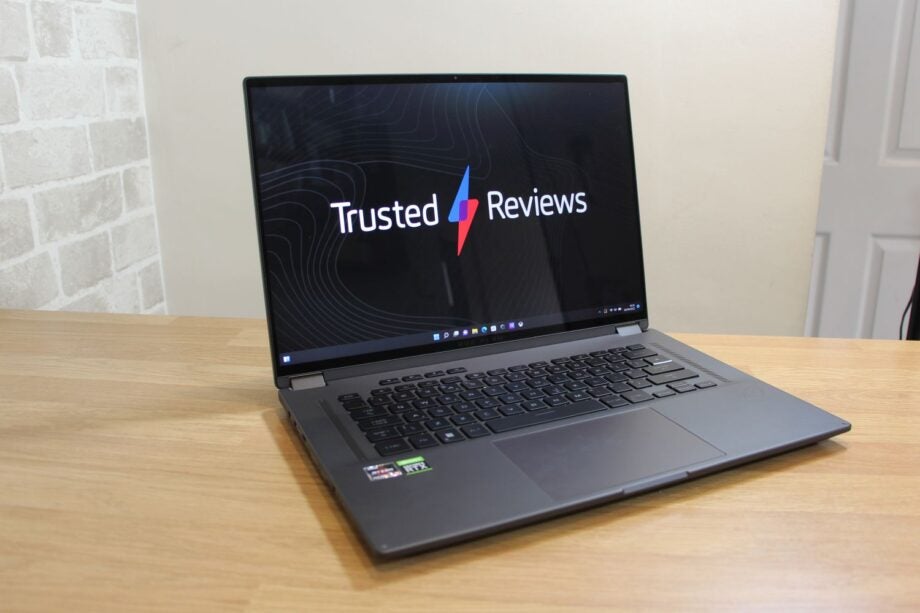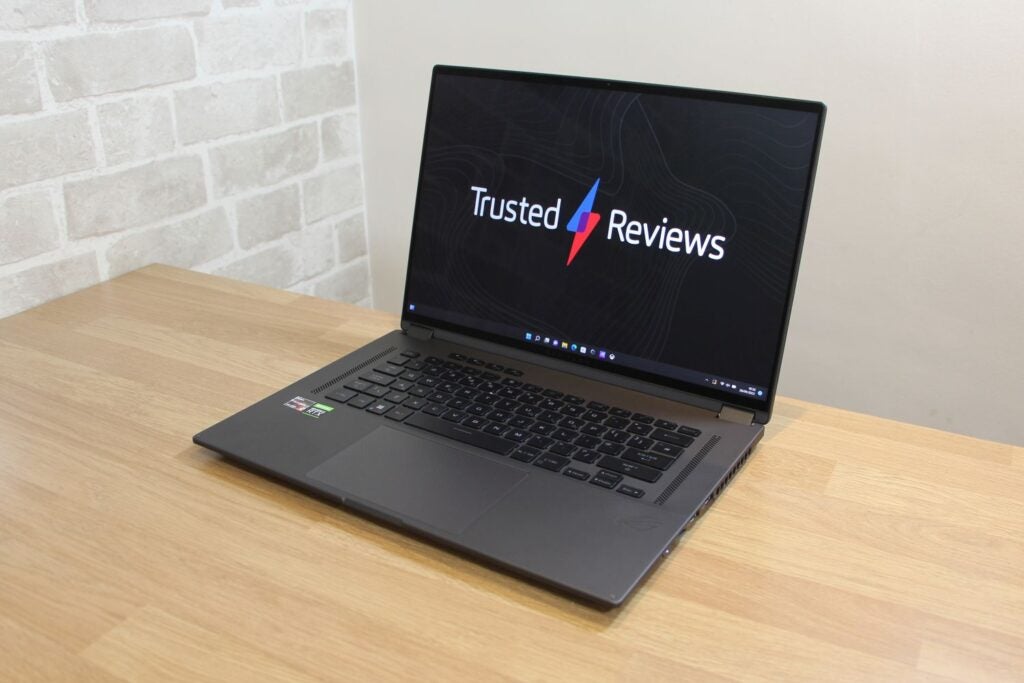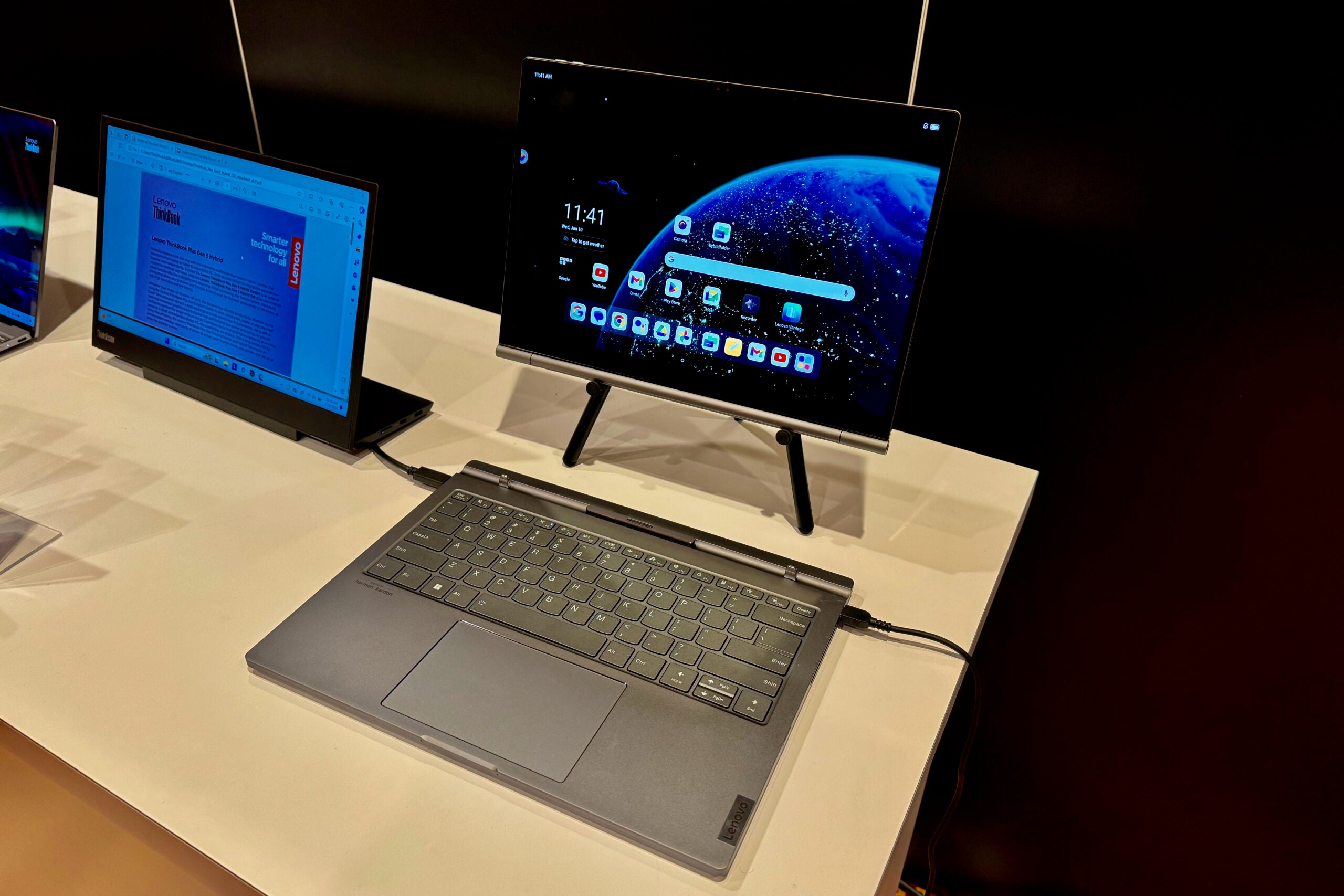Asus ROG Flow X16 Review
An innovative hybrid gaming laptop


Verdict
The Asus ROG Flow X16 is a versatile, impressive laptop with ample gaming power, a top-notch display and impressive keyboard and speaker quality. But you’ll get more performance from traditional laptops, connectivity could be better, and this notebook gets a bit too hot
Pros
- Impressive hybrid design
- Great gaming ability
- Bold, high-resolution screen
- Satisfying keyboard
Cons
- Faster, cheaper rivals available
- Hot, loud operation during games
- Missing connectivity features
Availability
- UKRRP: £2799
- USARRP: $2699
- EuropeRRP: €2998
Key Features
- A hybrid design to go beyond the conventional form factorIt’s unusual for a gaming laptop to have a hybrid design, but it works well on the Asus ROG Flow X16 – it allows users to play games and watch movies in tent mode, or to use the unit as a big gaming tablet or reading device.
- A high-resolution displayThe 2560 x 1600 panel has a 16:10 aspect ratio, so you’ve got plenty of space for games in all situations – and its 165Hz refresh rate delivers decent smoothness in every mainstream gaming situation.
- An internal mix of Nvidia and AMDThe Nvidia GeForce RTX 3070 Ti is a great mainstream gaming processor, and the AMD Ryzen 9 6900HS is a pretty fast CPU – but it’s outpaced by Intel’s more popular silicon.
Introduction
Asus has long been one of the most innovative laptop companies around, and the Asus ROG Flow X16 continues that tradition because it’s a gaming laptop that’s also a 2-in-1 hybrid device.
This design is usually found on ultraportables, but it makes plenty of sense to bring it across to a larger, more powerful laptop. It turns this 16-inch gaming notebook into a media playback device and a tablet, and could make it more versatile than rivals like the Razer Blade 15 and Alienware x15 R2.
But at $2699 in the US, £2799 in the UK and $2999 in Europe, this laptop isn’t cheap, and for that kind of cash you could buy one of the more conventional Razer or Alienware laptops. Is this experimental form factor worth the investment, or will the Asus ROG Flow X16 fall behind its more conventional competition and fail to trouble our best gaming laptop chart?
Design and Keyboard
- A sleek, effective convertible chassis with good build quality
- Reasonable connectivity, but no Thunderbolt and no HDMI 2.1
- A comfortable and fast keyboard despite the poor RGB LEDs
The convertible mechanism on the Asus ROG Flow X16 is a superb and straightforward bit of design. The display swings through 180 degrees smoothly on robust hinges, and the hybrid chassis adds versatility. Pitch the Flow into a tented position and you can prop it up to watch movies or play games with a pad.
Move it all the way around and it’s a large tablet for touchscreen gaming, or use it in portrait mode and it’s great for reading or web browsing – as long as you can cope with the increased size when compared to the average iPad.
The Flow’s aluminium and magnesium alloy body exhibits exceptional build quality throughout. It looks good too, with a lined aesthetic that eschews RGB LEDs for an industrial feel.

The dimensions are reasonable, although the Flow doesn’t always beat the competition. Positively, the Asus only weighs 2.1kg and it’s 19.4mm thick – so it’s lighter and slimmer than 17.3-inch competitors like the Alienware x17 R2 and Razer Blade 17. Negatively, though, the Alienware x15 and Razer Blade 15 are both slimmer, and the Razer is a little lighter too.
The Flow X16 is a bit inconsistent when it comes to connectivity, too. This laptop does have pairs of full-size USB 3.2 Gen 2 and Type-C ports, with the latter handling DisplayPort and power delivery, and it’s got a microSD card reader. On the inside, you’ll find dual-band Wi-Fi 6E and Bluetooth 5.2, and audio comes from a quartet of speakers that produce decent bass and a crisp, clear mid-range – they’re easily good enough for gaming.
You don’t get wired internet, though, and the laptop’s HDMI 2.0b output doesn’t offer the same bandwidth as HDMI 2.1 connections. Its webcam has Windows Hello, but there’s no fingerprint reader.

Unusually, the Flow x16 hides its second USB-C port inside the connector for the Asus XG Mobile external graphics dock, but Asus doesn’t sell the XG Mobile dock separately in many markets – and there isn’t a version available that outstrips the laptop’s RTX 3070 Ti GPU. It’s totally redundant.
Every competitor has HDMI 2.1 and faster Thunderbolt 4 ports – you don’t get the latter on the Asus. The Razer rigs have more full-size USB sockets and full-size SD card slots.
It’s a mixed keyboard, too. The buttons have 1.7mm of travel and it’s a satisfying, consistent unit that makes long gaming sessions feel good – but there’s no number pad and it’s only got unsophisticated single-zone RGB LED lighting. The trackpad is decent thanks to clicky buttons, but any keen gamer should attach a USB mouse.
If you really care about keyboard quality, you could buy an Alienware x17 R2 with a CherryMX mechanical unit, but it’ll cost you $3099/£2679/€3398, so in most markets it’ll cost extra.
Screen
- A large, high-resolution display with 16:10 aspect ratio
- Great quality for indoor and outdoor use
- Not available with the breadth of options you’ll find elsewhere
Unsurprisingly, the screen has a great specification – it’s arguably the most important component on a hybrid. The 16:10 aspect ratio and 2560 x 1600 resolution deliver a crisp, absorbing gaming experience with more vertical space than any rival – and the extra height makes it easier to read web pages and documents and provides additional width in portrait mode.
The touchscreen has a Gorilla Glass coating, and its 165Hz refresh rate comes with AMD FreeSync Premium Pro and a 3ms response time. Those latter specifications ensure smooth motion in single-player games and mainstream eSports situations.

Asus says this screen hits a 500-nit brightness level, and it went beyond that in benchmarks with a 543-nit peak. That’s high enough for indoor and outdoor use and it means that the Flow’s screen delivers impressive vibrancy in bright colours. The black point of 0.5 nits is reasonable, and the resulting contrast ratio of 1086:1 ensures good depth.
Rivals are slightly better, with increased depth in darker areas, but that won’t hinder gaming in any serious way.
The Flow produced all of the sRGB and DCI-P3 gamuts with a solid Delta E of 3.06, so you’ve got enough accuracy and breadth for any game. But while games and films look great on this screen, you’ll still get improved accuracy from Razer’s panels – they’re better for colour-sensitive workloads.
Alienware and Razer’s 2560 x 1440 screens lose vertical space but have 240Hz refresh rates, which are better for eSports. Razer also makes its 15-inch and 17.3-inch notebooks available with 360Hz screens, and the Alienware x17 R2 is sold with 480Hz and 4K display options. And, as always, 17.3-inch screens are even more absorbing than the Flow’s 16-inch panel – albeit in far larger laptops.
Performance
- Great mainstream gaming power from the RTX 3070 Ti
- The AMD processor is good, but Intel’s equivalent chips are better
- The Flow is sometimes too hot to touch in certain areas
Nvidia’s GeForce RTX 3070 Ti arrives inside the Asus ROG Flow X16 with its usual 8GB of memory and 5888 stream processors, and the GPU runs at its peak power output of 125W. AMD’s Ryzen 9 6900HS CPU has eight multi-threaded cores and a top speed of 4.9GHz,
There’s 32GB of dual-channel DDR5 memory, which is ample for gaming and creative work, and the 1TB SSD delivers great read and write speeds of 6574MB/sec and 4478MB/sec.
In Horizon Zero Dawn at 2560 x 1600 the Asus averaged 68fps, and in Borderlands 3 the Asus zipped through at 46fps – this laptop will play big-name games smoothly. There’s plenty of eSports ability here, too: in Rainbow Six Siege the Asus averaged 230fps.

You’ll only have to tone down graphics settings in particularly demanding games, or if you’d like to achieve consistent 60fps frame rates in the toughest titles.
That said, you can get more GPU power if you spend extra on a laptop with an RTX 3080 Ti – that core averaged 120fps in Horizon at 1080p, while the Flow managed 87fps.
AMD’s Ryzen 9 processor scored 1556 and 10,067 in Geekbench 5’s single- and multi-core tests. Those good results mean that you’ve got enough processing ability to tackle work tasks, multi-tasking, photo-editing and video processing – it’s a capable content-creation chip.
There’s a reason why every rival uses Intel silicon. The Core i7-12700H scored 1,686 and 12,040 in the same benchmarks in the Alienware x17. In PC Mark 10 the Asus scored a respectable 7529, but the i7-12700H hit nearly 8000 points in the same test.
| Asus ROG Flow X16 | Alienware x17 R2 | Razer Blade 17 | |
| CPU | AMD Ryzen 9 6900HS | Intel Core i7-12700H | Intel Core i7-12800H |
| PCMark10 | 7529 | 7856 | 7388 |
| Geekbench 5 Single / Multi | 1556 / 10,067 | 1686 / 12,040 | 1804 / 13,144 |
| GPU | Nvidia RTX 3070 Ti | Nvidia RTX 3080 Ti | Nvidia RTX 3080 Ti |
| 3DMark Time Spy | 8991 | 12,486 | 12,671 |
Laptops with the i7-12700H don’t cost any more than the Asus, either – you’ll find that chip inside every Alienware and Razer rig. Many laptops in this price range are also available with the faster Core i9-12900H.
You’ll also have to be careful of the Flow’s thermal performance. If you play high-end games for a prolonged period then the underside and the metal above the keyboard both become too hot to touch – tricky if you want the Flow on your lap. There’s a fair amount of fan noise, too, although no more than you’ll find elsewhere, so the speakers or a good headset will block that out.
Battery
- You’ll get most of a day out of this laptop if you’re careful
- Don’t expect more than an hour of gameplay here, though
The longevity of the Asus ROG Flow X16 is mixed, but not disastrous. While playing video at 150 nits the Asus lasted for almost eight hours, so you can use the Flow to watch movies or episodes of your favourite TV shows – or to get through most of a working day in undemanding apps.

In a tougher work test the Flow delivered 4hrs 35mins of usage, which is on par with the Razer Blade 15 and a bit better than the Alienware – and longer than both 17.3-inch rivals. That will only get you through until lunchtime, but it still allows you more versatility than many gaming notebooks.
In games, the Flow lasted for 57 minutes, which is an unsurprisingly poor result – and, when gaming on the battery, you get reduced GPU performance anyway. To play top titles, stick to the mains, and only use the battery for less-intensive casual games in tablet mode.
Latest deals
Should you buy it?
You’d like a gaming laptop with great tablet and media ability
The Asus has a sleek, versatile hybrid design, a great screen and a good Nvidia GPU, so it has the power to function well in loads of different gaming and media situations
You’d prefer ultimate power and more ports
The RTX 3070 Ti is easily outpaced by other Nvidia GPUs, and AMD’s processor regularly falls behind Intel chips. Other laptops have better connectivity, too, including Thunderbolt 4
Final Thoughts
The Asus ROG Flow X16 has good mainstream gaming power, a great 16:10 display and a slick hybrid design, so it’s a great choice if you want versatility and a touchscreen from a gaming notebook – but it’s sometimes hot, and you’ll find more power and connectivity from more conventional models.
If you like the idea of a hybrid gaming laptop, but fancy a more portable device, we recommend checking out the Asus ROG Flow Z13 too.
How we test
Every gaming laptop we review goes through a series of uniform checks designed to gauge key things including build quality, performance, screen quality and battery life.
These include formal synthetic benchmarks and scripted tests, plus a series of real world checks, such as how well it runs when running a AAA game.
We used as our main laptop for at least a week.
Tested the performance via both benchmark tests and real-world use.
We tested the screen with a colorimeter and real-world use.
We tested the battery with a benchmark test and real-world use.
FAQs
Yes, the ROG Flow is designed to be used as both a laptop and tablet, so it does support touch controls.
It’s certainly powerful enough for video editing, but you’ll find other laptops with more colour-sensitive screens at a more affordable price, including the MacBook Pro and the Asus ZenBook Pro 16X OLED.
Trusted Reviews test data
Full specs
Sustainability
TrustedReviews’ holds the fact that global warming is not a myth as a core value and will continuously endeavor to help protect our planet from harm in its business practices.
As part of this mission, whenever we review a product we send the company a series of questions to help us gauge and make transparent the impact the device has on the environment.
We currently haven’t received answers to the questions on this product, but will update this page the moment we do. You can see a detailed breakdown of the questions we ask and why in our sustainability info page.








